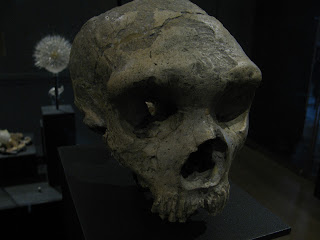 |
| Our group on the steps of the museum's main entrance. (Photo: Paul Ramsay) |
Despite bringing a group of 46 to the museum, we were taken through the doors closed to the public, into the basements and along the corridors, to the scientific collection, where the real work is done. We also had the chance to catch up with four of our graduates, now working at the NHM, three in paid jobs there and a fourth getting experience on an internship.
With so many people, we split into two smaller groups for visits to the fish and entomology sections. Then we had a chance to see the public face of the museum, before heading home. Here are some photos from the visit...
 |
| Behind-the-scenes at the museum. (Photo: Paul Ramsay) |
 |
| An alizarin preparation, which makes the fish's flesh transparent, but stains bone and cartillage. This technique has promoted an understanding of how fish develop. (Photo: Paul Ramsay) |
 |
| Dr Ollie Crimmen was our generous host in the fish collection. (Photo: Paul Ramsay) |
 |
| Preserved specimens like this are essential for describing the world's biodiversity. Without this reference material, names can be disputed. (Photo: Paul Ramsay) |
 |
| One of Charles Darwin's fish specimens collected during his time on the Beagle--a link to Plymouth, from where the ship set sail (Photo: Paul Ramsay) |
 |
| Dr Max Barclay explained the work of the entomology section, with a stunning set of specimens. (Photo: Paul Ramsay) |
 |
| Beetles collected by Joseph Banks on his voyage with Captain James Cook. Another link to Plymouth's history of scientific exploration. (Photo: Paul Ramsay) |
 |
| Entomological "bling": Chrysina resplendens from Costa Rica and Panamá. (Photo: Paul Ramsay) |
 |
| A selection of specimens collected by Alfred Russell Wallace. (Photo: Paul Ramsay) |
 |
| One of the specimens collected by Alfred Russell Wallace. (Photo: Paul Ramsay) |
 |
| The world's biggest beetle: Titanus giganteus. (Photo: Paul Ramsay) |
 |
| This scarab beetle carving was entombed with an Egyptian mummy. (Photo: Paul Ramsay) |
 |
| (Photo: Paul Ramsay) |
 |
| (Photo: Paul Ramsay) |
 |
| Fergus McBurney is a recent graduate from the Conservation Biology course and is currently gaining experience at the museum. (Photo: Paul Ramsay) |
 |
| An example of Fergus' handywork today. (Photo: Paul Ramsay) |
 |
| Fergus showing off a Scolopendra centipede from the "wet collection". (Photo: Paul Ramsay) |
 |
| The museum at the end of the day, when the school kids have gone. (Photo: Paul Ramsay) |
 |
| The building is worth the visit in itself. (Photo: Paul Ramsay) |
 |
| A dodo skeleton. (Photo: Paul Ramsay) |
 |
| A fossilized gliphodon. (Photo: Paul Ramsay) |
 |
| Archaeopteryx fossil showing the tail feather in detail. (Photo: Paul Ramsay) |
 |
| Neandertal skull. (Photo: Paul Ramsay) |
 |
| A first edition of Charles Darwin's famous book. (Photo: Paul Ramsay) |
 |
| Part of an illustration from John James Audubon's Birds of America. (Photo: Paul Ramsay) |

No comments:
Post a Comment